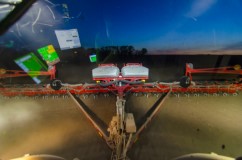|
|
Freedom, WI | I am looking at buying one of these for baling some horse hay (how I got stuck doing things with horses, please don't ask; my sister bought one and it all went downhill from there :) The riding instructor said that if you have a baler you could pick up some smaller jobs in the area. I have a friend that has some ground that he would want to put hay on and we would work together on that. I found one for around $6000 that might be worth a look. What do I need to know about an inline baler? How do they differ from a standard one? It is going to be in grassy hay. How big of bale size can I expect? (size+weight) Overall, are they a good machine or not? Would you say it is better or worse than say a 316 New Holland? Needless to say, I know next to nothing about balers at the moment because I have never actually baled with one before. Any help is appreciated! |
|
| |
|
wisconsin | I just sold one that i had for about 7 years. I made about a 36" bale. I think you can make them as long as appr. 50". Not sure on that. Made a very nice bale. My bales would average between 40 to 45 lbs. I sold most to horse people and that was the perfect size. Really had no problems with the baler and it tied excellent. By the way, I got $5400 for mine. it had a thrower. good luck. |
|
| |
|

| I have one. Good little baler. |
|
| |
|

| That's a decent price for one in good condition. They don't like big wads of hay, best to not get less than about 13-14 strokes per bale- but it runs 105 strokes per minute, so if you do a quality job of raking and run the baler with some situational awareness you can put out a lot of nice bales in an hour. I'd put it on par with a 570 New Holland, but superior to a 316. |
|
| |
|
NWWI | We got a 8545 inline last year with hydraulic pick up and bale tension w/thrower and rebuilt knotters for 9k and did 15000 bales with only a thrower bearing go out. They will run circles around 316 NH imo. They have a nice wide pick up and you drive right down the windrow, might take a little getting getting used to if you are used to side pull, but I think you will like it. They run very fast plunger speed and like to eat hay. Last winter went through a 8530 for a guy it had 90000 bales through it, everything on knotters was worn out, but still wasn't missing many bales in his mind, (3 per load) but the plunger didn't have any bearings on it for awhile! There was about approx 1600$ put in plunger/ knives and knotters in parts it also needed some work on p.u. If you got a prybar and flashlight and roll plunger to rear of chamber you can lift up on plunger to see how worn things are. Billhooks and knife arms that are worn you should be able to see twine wear. Also the baler last winter had the porcelain insulators by needles worn through. You may need to be aware of the traveling knotter fixit guy, that would drill or machine out pieces to fix them but then oem parts will not fit any more w/o major parts being replaced ! I think he was from Menomonie area.
|
|
| |
|
s.e. Pa | I think 8545 is the biggest of the series. It probably is faster than a 316, a 326 would probably be a better comparison. The thing about a 316 (at least here) is that they are so easy to get parts and service for. There are only a handful of inlines around and a dealer to work on one is at least an hour away. I am also not sure that you could get much better than a 316 for reliability. Inline probably makes more uniform, square bales. Are there two different styles of knitters in older inlines? I remember someone telling me that there was one style that was less desirable.
Josh |
|
| |
|

| When I first got my 8530, I worked on a 316 for a neighbor and he told me to take it out and use it and make sure everything was running o.k. 8530 would easily outbale it, imho. Was kind of dissapointed after hearing so much about them. 8530 and 8540 are real similar. The 40's just have hydraulic pickups and density etc. |
|
| |


 Case 8530 Baler
Case 8530 Baler

